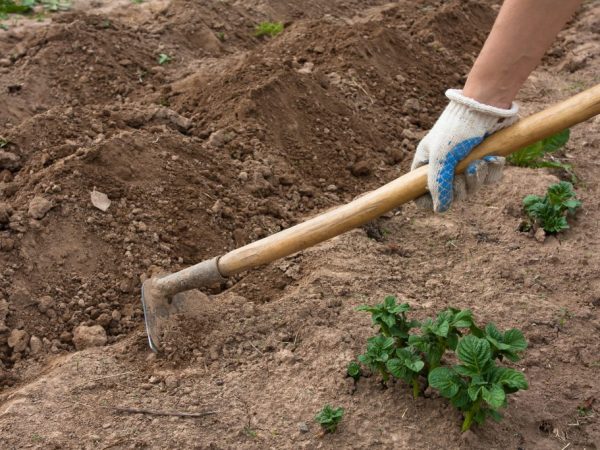How to sprinkle potatoes by hand
Growing potatoes involves planting, nursing and harvesting. Hilling potatoes by hand, with a special device or walk-behind tractor is one of the important processes of caring for a crop. The choice of method depends on the size of the site.

Hilling potatoes by hand
The purpose of the operation
Hilling of potatoes is carried out to increase yields by protecting bushes and tubers from bad weather. During the operation, the soil is loosened, which allows the roots to be saturated with oxygen and moisture.
When tubers appear, the fruits are close to the surface, which leads to baking in the sun or frostbite when the temperature drops at night. Hilling potatoes helps protect the potatoes.
Hilling effect:
- protection of the plant from bad weather conditions;
- an increase in the number of tubers;
- preventing the appearance of pests;
- the formation of bushes that do not shade the rest;
- strengthening the stems.
Execution rules
Hilling should be done according to the following rules:
- The first operation is carried out when shoots with a height of 8-12 cm appear. In cold climates, the bushes are completely covered with earth to protect young plants from frost. In warm climates, the hilling of potatoes is carried out later.
- Hilling a second time is required when tubers are formed. It is important to do this before flowering. The appropriate period is 14-20 days after the first procedure.
- It is better to huddle the last time when the bushes reach a height of 23-26 cm. The base is sprinkled with earth. Also, the soil is scattered between the branches so that they grow wider.
The procedure is carried out on damp ground during the cool part of the day. Ideal - morning or evening after rain. This brings additional moisture to the potatoes when hilling. When flowers appear, the procedure is carried out carefully so as not to damage the tubers during the period of tying.
The operation is not performed with dry soil: this complicates the development of the plant and makes it vulnerable to pests.
Manual hilling
There are 2 ways of manual hilling
- Shoveling. A mound is formed from the ground near the base of the bush so that the stems grow upward.
- Putting the earth inside the bush. Before throwing the soil, the stems are spread apart so that after hilling they are fixed and grow in different directions.
The operation is carried out manually using a hoe and a shovel. The use of such hand tools is rational only in small areas.

Hilling helps protect the root system
When using a hoe, the ground is pulled towards the bush to create a slight elevation. With a shovel, the soil is simply thrown to the base of the plant. The resulting mound should be high and wide so that the entire root system and base of the plant are protected.
Using a hand fixture
Plowing potatoes with a hand plow is faster and more efficient. The advantages of the device are maneuverability, simplicity of design and versatility. The hiller is modernized for cutting furrows during planting and into a tool for inter-row processing.
The design consists of a frame, a working body and blades for adjusting the working depth. For use, 1 person is required who sets the device into operation and monitors the direction.
There are 2 types of manual hillers:
- working body in the form of a plow;
- disk.
When using a manual hiller, the potatoes must be planted in an even row. For this, it is best to use a marker when cutting furrows. When moving, the working body cuts the soil in the aisles and spreads it to the sides on the bushes. To avoid the risk of damaging the fruit, it is necessary to precisely set the angle of attack and drive the hiller straight.
Making a manual hiller
To reduce the cost of caring for potatoes, the hillers are collected by hand.
The positive aspects of a self-assembled hiller:
- cheapness;
- the possibility of manufacturing, based on personal preferences;
- adjustment to the type of soil;
- the possibility of modernization for other purposes.
The downside is the lack of quality assurance. Factory hillers for potatoes are produced according to standards, and the quality of homemade ones depends only on the manufacturer and materials.
To make a manual hiller you will need:
- 1 m long tube empty inside;
- thin pipe for the manufacture of traction and lintels;
- steel plate 1 mm thick for dumps;
- soldering small for bending metal;
- lanyard;
- saw with a disc for metal;
- welding machine.
Assembling the device
Manufacturing procedure:
- Vertical stand. A meter pipe is bent at a distance of 35 cm from the edge.
- Manufacturing of rear and front rods. Do the same, but with a smaller diameter pipe.
- Assembly of a two-moldboard working body. The plow is made of round metal plates. Pot lids will work. They are installed at an angle to each other and welded to the rack.
- Making a pruning knife. The tool is made of strong material, since it takes on the main load when moving. For this, a steel sheet is suitable, which is cut in the shape of an arrow with a sharp cutting part. It is welded to the frame and polished.
Conclusion
Hilling potatoes by hand is rational in small areas. For large gardens, it is better to purchase a walk-behind tractor or a motor-cultivator: this will significantly speed up the processing process.
When growing potatoes, you need to monitor the state of the row spacings. Hilling is prohibited with a large number of weeds. They need to be cut and weeded.


